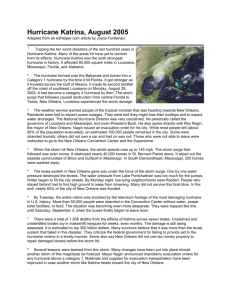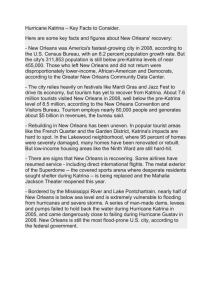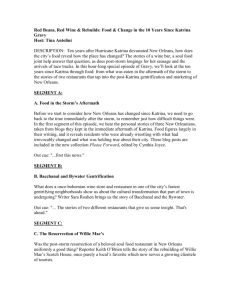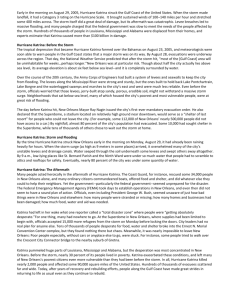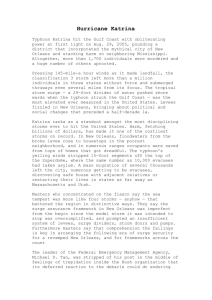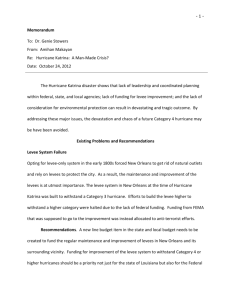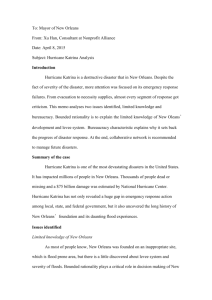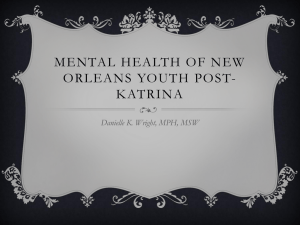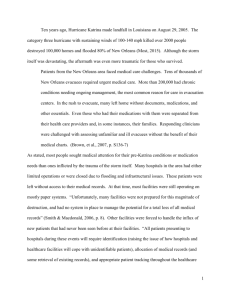Lesson 10: Hurricane Katrina Info Sheet
advertisement
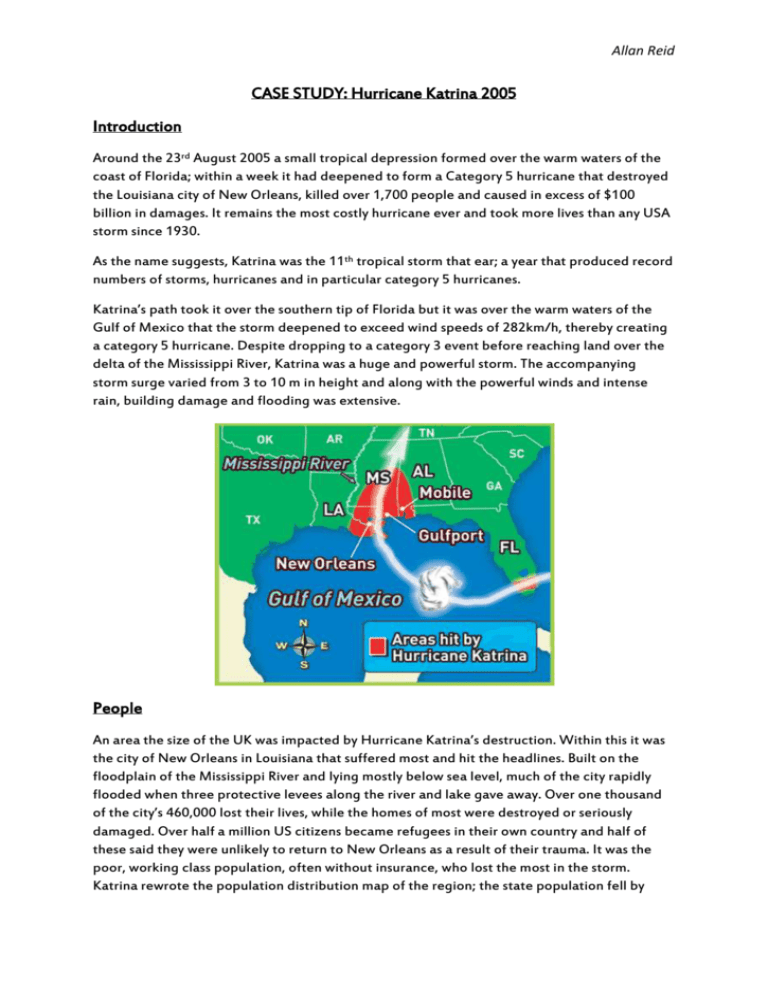
Allan Reid CASE STUDY: Hurricane Katrina 2005 Introduction Around the 23rd August 2005 a small tropical depression formed over the warm waters of the coast of Florida; within a week it had deepened to form a Category 5 hurricane that destroyed the Louisiana city of New Orleans, killed over 1,700 people and caused in excess of $100 billion in damages. It remains the most costly hurricane ever and took more lives than any USA storm since 1930. As the name suggests, Katrina was the 11th tropical storm that ear; a year that produced record numbers of storms, hurricanes and in particular category 5 hurricanes. Katrina’s path took it over the southern tip of Florida but it was over the warm waters of the Gulf of Mexico that the storm deepened to exceed wind speeds of 282km/h, thereby creating a category 5 hurricane. Despite dropping to a category 3 event before reaching land over the delta of the Mississippi River, Katrina was a huge and powerful storm. The accompanying storm surge varied from 3 to 10 m in height and along with the powerful winds and intense rain, building damage and flooding was extensive. People An area the size of the UK was impacted by Hurricane Katrina’s destruction. Within this it was the city of New Orleans in Louisiana that suffered most and hit the headlines. Built on the floodplain of the Mississippi River and lying mostly below sea level, much of the city rapidly flooded when three protective levees along the river and lake gave away. Over one thousand of the city’s 460,000 lost their lives, while the homes of most were destroyed or seriously damaged. Over half a million US citizens became refugees in their own country and half of these said they were unlikely to return to New Orleans as a result of their trauma. It was the poor, working class population, often without insurance, who lost the most in the storm. Katrina rewrote the population distribution map of the region; the state population fell by Allan Reid over 8% and within Louisiana, areas outside New Orleans grew in numbers as the city’s people fled. In the coastal state if Mississippi 109,000 were made homeless and over 230 died. The FEMA later helped 108,000 people with unemployment benefit. Property Housing damage and destruction was widespread and stretched up to 100 km from the storm centre. At least 100,000 temporary homes were needed across the region. Services in New Orleans were severely damaged. Even six months after the event the city centre had no functioning sewage system, and gas and electricity supplies were not available. Agriculture suffered heavy losses including the death of nine million poultry in Mississippi, while in the same state the dairy industry lost $12 million. The forest industry in the region was affected; over one million acres of forest was destroyed. Due to Katrina, a total financial loss to the timber industry is estimated at $5 billion. The US Corps of Engineers, the group responsible for river management, estimated that in Louisiana there were over 70 million cubic metres of storm debris to be removed. In the aftermath of Katrina hundreds of thousands of local residents were left without work. This will have a trickle-down effect with lover income tax being paid to the US Government. It is estimated that Katrina’s total economic impact in Louisiana and Mississippi will exceed $150 billion. Protective Measures for people and property Statistics would suggest that in general in the USA, protection from hurricanes is successful in terms of lives not property. Despite decades of increasing population in hurricane-prone regions of the nation, essentially the south eastern states, the storm death toll has generally fallen. Katrina was a shock for a country where deaths from hurricanes was now a rarity. Property damage paints a different picture; with an increasing number of inhabitants – and moreover wealthier ones, especially on the storm-surge-prone coasts of Mississippi and Florida – the fixed property at risk has grown. Homes, yachts, cars and other possessions must often be abandoned, though secured as much as possible, during hurricane events. So while prediction and evacuation works well for the population, it is not the answer for their possessions. 1. Prediction and Warning In August 2005 Hurricane Katrina was precisely tracked from the initiation to the conclusion of its short but violent life. Katrina’s scale, strength and landfall locations, first in Florida and later in the delta region, were accurately predicted. Despite the years of investment and numerous warnings of the threat that a major hurricane posed to the people of New Orleans, evacuation plans proved inadequate. Following the event, a Congressional Report described the government’s response to Katrina’s impact as a national failure, stating that “…clumsiness and ineptitude… Allan Reid 2. 3. 4. 5. characterised behaviour before and after this storm”. Part of the problem was that over 25% of households in New Orleans did not own cars and had no easy way of evacuating the city. Residents also refused to leave their homes, fearing looting in their absence; some paid for this inaction with their lives. Education It appears that despite the official awareness of the risk to New Orleans, most residents had little fear that the city would be badly impacted. Building Codes In New Orleans the city’s situation – much of it lies below sea level – meant that the flooding was so severe that even the strict building codes did little to reduce the impact. In the aftermath some people have suggested that the worst affected areas of the city should not be rebuilt on such a dangerous site. Others have suggested that the worst affected areas should not be redeveloped but that a smaller population should be catered for, and the flood-prone regions given over to low risk land uses such as parkland or sports pitches. Coastal and river engineering The levees and defences along the Mississippi and canals in New Orleans were built to withstand a hurricane up to a category 3, anything beyond that would cause flooding. The cost and practicality of protecting the city and the rest of the region from the worst possible event is prohibitive. Currently the US Corps of engineers, who have the task of rebuilding New Orleans defences, is restoring them to their previous height while the city’s mayor wants them raised and improved to deal with category 5 hurricanes. Insurance Most households in New Orleans could not afford the premiums required to cover hurricane damage and this explains why in the hardest-hit, working class regions of the city many of the residents have decided not to return.


